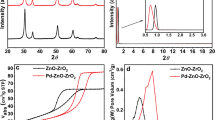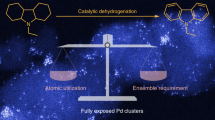Abstract
The development of catalysts able to assist industrially important chemical processes is a topic of high importance. In view of the catalytic capabilities of small metal clusters, research efforts are being focused on the synthesis of novel catalysts bearing such active sites. Here we report a heterogeneous catalyst consisting of Pd4 clusters with mixed-valence 0/+1 oxidation states, stabilized and homogeneously organized within the walls of a metal–organic framework (MOF). The resulting solid catalyst outperforms state-of-the-art metal catalysts in carbene-mediated reactions of diazoacetates, with high yields (>90%) and turnover numbers (up to 100,000). In addition, the MOF-supported Pd4 clusters retain their catalytic activity in repeated batch and flow reactions (>20 cycles). Our findings demonstrate how this synthetic approach may now instruct the future design of heterogeneous catalysts with advantageous reaction capabilities for other important processes.
This is a preview of subscription content, access via your institution
Access options
Access Nature and 54 other Nature Portfolio journals
Get Nature+, our best-value online-access subscription
$29.99 / 30 days
cancel any time
Subscribe to this journal
Receive 12 print issues and online access
$259.00 per year
only $21.58 per issue
Buy this article
- Purchase on Springer Link
- Instant access to full article PDF
Prices may be subject to local taxes which are calculated during checkout




Similar content being viewed by others
References
Argo, A. M., Odzak, J. F., Lai, F. S. & Gates, B. C. Observation of ligand effects during alkene hydrogenation catalysed by supported metal clusters. Nature 415, 623–626 (2002).
Corma, A. et al. Exceptional oxidation activity with size-controlled supported gold clusters of low atomicity. Nat. Chem. 5, 775–781 (2013).
Oliver-Meseguer, J., Cabrero-Antonino, J. R., Dominguez, I., Leyva-Perez, A. & Corma, A. Small gold clusters formed in solution give reaction turnover numbers of 107 at room temperature. Science 338, 1452–1455 (2012).
Wang, N. et al. In situ confinement of ultrasmall Pd clusters within nanosized silicalite-1 zeolite for highly efficient catalysis of hydrogen generation. J. Am. Chem. Soc. 138, 7484–7487 (2016).
Yamamoto, K. et al. Size-specific catalytic activity of platinum clusters enhances oxygen reduction reactions. Nat. Chem. 1, 397–402 (2009).
Boronat, M., Leyva-Pérez, A. & Corma, A. Theoretical and experimental insights into the origin of the catalytic activity of subnanometric gold clusters: attempts to predict reactivity with clusters and nanoparticles of gold. Acc. Chem. Res. 47, 834–844 (2014).
Campbell, C. T. The effect of size-dependent nanoparticle energetics on catalyst sintering. Science 298, 811–814 (2002).
Lei, Y. et al. Increased silver activity for direct propylene epoxidation via subnanometer size effects. Science 328, 224–228 (2010).
Tyo, E. C. & Vajda, S. Catalysis by clusters with precise numbers of atoms. Nat. Nanotech. 10, 577–588 (2015).
Murahashi, T. Discrete sandwich compounds of monolayer palladium sheets. Science 313, 1104–1107 (2006).
Liu, L. et al. Generation of subnanometric platinum with high stability during transformation of a 2D zeolite into 3D. Nat. Mater. 16, 132–138 (2017).
Serna, P. & Gates, B. C. Molecular metal catalysts on supports: organometallic chemistry meets surface science. Acc. Chem. Res. 47, 2612–2620 (2014).
Okrut, A. et al. Selective molecular recognition by nanoscale environments in a supported iridium cluster catalyst. Nat. Nanotech. 9, 459–465 (2014).
Furukawa, H., Cordova, K. E., O’Keeffe, M. & Yaghi, O. M. The chemistry and applications of metal-organic frameworks. Science 341, 974–986 (2013).
Gascon, J., Corma, A., Kapteijn, F. & Llabrés i Xamena, F. X. Metal organic framework catalysis: quo vadis? ACS Catal. 4, 361–378 (2014).
Moon, H. R., Lim, D.-W. & Suh, M. P. Fabrication of metal nanoparticles in metal–organic frameworks. Chem. Soc. Rev. 42, 1807–1824 (2013).
Li, X. et al. Controlling catalytic properties of Pd nanoclusters through their chemical environment at the atomic level using isoreticular metal–organic frameworks. ACS Catal. 6, 3461–3468 (2016).
Liu, H. et al. Controllable encapsulation of ‘clean’ metal clusters within MOFs through kinetic modulation: towards advanced heterogeneous nanocatalysts. Angew. Chem. Int. Ed. 55, 5019–5023 (2016).
Liu, L. et al. Size-confined growth of atom-precise nanoclusters in metal–organic frameworks and their catalytic applications. Nanoscale 8, 1407–1412 (2016).
Yang, Q., Xu, Q., Yu, S.-H. & Jiang, H.-L. Pd Nanocubes@ZIF-8: integration of plasmon-driven photothermal conversion with a metal-organic framework for efficient and selective catalysis. Angew. Chem. Int. Ed. 55, 3685–3689 (2016).
Seidel, G. & Fürstner, A. Structure of a reactive gold carbenoid. Angew. Chem. Int. Ed. 53, 4807–4811 (2014).
Wu, X.-F., Anbarasan, P., Neumann, H. & Beller, M. From noble metal to nobel prize: palladium-catalyzed coupling reactions as key methods in organic synthesis. Angew. Chem. Int. Ed. 49, 9047–9050 (2010).
Albéniz, A. C., Espinet, P., Manrique, R. & Pérez-Mateo, A. Observation of the direct products of migratory insertion in aryl palladium carbene complexes and their subsequent hydrolysis. Angew. Chem. Int. Ed. 41, 2363–2366 (2002).
Fillion, E. & Taylor, N. J. Cine-substitution in the stille coupling: evidence for the carbenoid reactivity of sp 3 - g em -Organodimetallic iodopalladio-trialkylstannylalkane intermediates. J. Am. Chem. Soc. 125, 12700–12701 (2003).
Qin, G., Li, L., Li, J. & Huang, H. Palladium-catalyzed formal insertion of carbenoids into aminals via C–N bond activation. J. Am. Chem. Soc. 137, 12490–12493 (2015).
Solé, D., Mariani, F., Bennasar, M.-L. & Fernández, I. Palladium-catalyzed intramolecular carbene insertion into C(sp 3)-H bonds. Angew. Chem. Int. Ed. 55, 6467–6470 (2016).
Gutiérrez-Bonet, Á., Juliá-Hernández, F., de Luis, B. & Martin, R. Pd-catalyzed C(sp 3)–H functionalization/carbenoid insertion: all-carbon quaternary centers via multiple C–C bond formation. J. Am. Chem. Soc. 138, 6384–6387 (2016).
McKervey, M. A., Tuladhar, S. M. & Twohig, M. F. Efficient synthesis of bicyclo[5.3.0]decatrienones and of 2-tetralones via rhodium(II) acetate-catalysed cyclisation of α-diazoketones derived from 3-arylpropionic acids. J. Chem. Soc. Chem. Commun. 129–130 (1984).
Anciaux, A. J. et al. Transition-metal-catalyzed reactions of diazo compounds. 2. Addition to aromatic molecules: catalysis of Buchner’s synthesis of cycloheptatrienes. J. Org. Chem. 46, 873–876 (1981).
Maestre, L. et al. A fully recyclable heterogenized Cu catalyst for the general carbene transfer reaction in batch and flow. Chem. Sci. 6, 1510–1515 (2015).
Brozek, C. K. & Dincă, M. Cation exchange at the secondary building units of metal-organic frameworks. Chem. Soc. Rev. 43, 5456–5467 (2014).
Grancha, T. et al. Postsynthetic improvement of the physical properties in a metal-organic framework through a single crystal to single crystal transmetallation. Angew. Chem. Int. Ed. 54, 6521–6525 (2015).
Mon, M. et al. Selective gold recovery and catalysis in a highly flexible methionine-decorated metal–organic framework. J. Am. Chem. Soc. 138, 7864–7867 (2016).
Mon, M. et al. Selective and efficient removal of mercury from aqueous media with the highly flexible arms of a BioMOF. Angew. Chem. Int. Ed. 55, 11167–11172 (2016).
Murahashi, T., Uemura, T. & Kurosawa, H. Perylene-tetrapalladium sandwich complexes. J. Am. Chem. Soc. 125, 8436–8437 (2003).
Murahashi, T., Kato, N., Uemura, T. & Kurosawa, H. Rearrangement of a Pd4 skeleton from a 1D chain to a 2D sheet on the face of a perylene or fluoranthene ligand caused by exchange of the binder molecule. Angew. Chem. Int. Ed. 46, 3509–3512 (2007).
Mealli, C. et al. Theoretical aspects of the heterobimetallic dimers with the T over square structural motif. Synthesis and structure of a heteronuclear platinum and palladium complex with 1-methylcytosinato bridging ligands. Inorg. Chem. 34, 3418–3424 (1995).
Murahashi, T. & Kurosawa, H. Organopalladium complexes containing palladium-palladium bonds. Coord. Chem. Rev. 231, 207–228 (2002).
Fernández-García, M. et al. Role of the state of the metal component on the light-off performance of Pd-based three-way catalysts. J. Catal. 221, 594–600 (2004).
Liang, B., Zhou, M. & Andrews, L. Reactions of laser-ablated Ni, Pd, and Pt atoms with carbon monoxide: matrix infrared spectra and density functional calculations on M(CO)n (n = 1–4), M(CO)n (n = 1–3), and M(CO)n+ (n = 1–2), (M = Ni, Pd, Pt). J. Phys. Chem. A 104, 3905–3914 (2000).
Willner, H. et al. Superelectrophilic tetrakis(carbonyl)palladium(II)- and -platinum(II) undecafluorodiantimonate(V), [Pd(CO)4][Sb2F11]2 and [Pt(CO)4][Sb2F11]2: syntheses, physical and spectroscopic properties, their crystal, molecular, and extended structures, and density functional calculations: an experimental, computational, and comparative study. J. Am. Chem. Soc. 123, 588–602 (2001).
Nefedov, V. I. et al. ESCA and X-ray spectral study of Pd(0), Pd(I) and Pd(II) compounds with triphenylphosphine ligands. Inorg. Chim. Acta 35, L343–L344 (1979).
Searle, N. E. Ethyl diazoacetate. Org. Synth. 36, 25 (1956).
Ranocchiari, M. & Mezzetti, A. Ru/PNNP-catalyzed asymmetric imine aziridination by diazo ester activation. Organometallics 28, 3611–3613 (2009).
Horiuchi, S. et al. Multinuclear metal-binding ability of a carotene. Nat. Commun. 6, 6742 (2015).
Barder, T. E. Synthesis, structural, and electron topographical analyses of a Dialkylbiaryl Phosphine/Arene-Ligated Palladium(I) dimer: enhanced reactivity in Suzuki–Miyaura coupling reactions. J. Am. Chem. Soc. 128, 898–904 (2006).
Yin, G., Kalvet, I. & Schoenebeck, F. Trifluoromethylthiolation of aryl iodides and bromides enabled by a bench-stable and easy-to-recover dinuclear Palladium(I) catalyst. Angew. Chem. Int. Ed. 54, 6809–6813 (2015).
Maas, G. New syntheses of diazo compounds. Angew. Chem. Int. Ed. 48, 8186–8195 (2009).
Kennedy, M., McKervey, M. A., Maguire, A. R., Tuladhar, S. M. & Twohig, M. F. The intramolecular Buchner reaction of aryl diazoketones. Substituent effects and scope in synthesis. J. Chem. Soc. Perkin Trans. 1, 1047–1054 (1990).
Pereira, A. et al. Copper-carbene intermediates in the copper-catalyzed functionalization of O–H bonds. Chem. A Eur. J. 21, 9769–9775 (2015).
Acknowledgements
This work was supported by the MINECO (Spain) (Projects CTQ2013-46362-P, CTQ2014-56312-P and Excellence Units ‘Severo Ochoa’ and ‘Maria de Maeztu’ SEV-2012-0267 and MDM-2015-0538), the Generalitat Valenciana (Spain) (Project PROMETEOII/2014/070), the Ministero dell’Istruzione, dell’Università e della Ricerca (Italy) and the Junta de Andalucía (FQM-195 and P11-FQM-7756). M.M. thanks the MINECO for a predoctoral contract. Thanks are also extended to the Ramón y Cajal Program and the ‘Convocatoria 2015 de Ayudas Fundación BBVA a Investigadores y Creadores Culturales’ (E.P., A.L.-P. and J.F.-S.). J.G. acknowledge the financial support of the European Research Council under the European Union’s Seventh Framework Programme (FP/2007-2013)/ERC Grant Agreement no. 335746, CrystEng-MOF-MMM.
Author information
Authors and Affiliations
Contributions
E.P., A.L.-P., A.C. and D.A. designed the research; E.P. and J.F.-S. coordinated the whole work; F.R.F.-P. and M.M. performed synthetic work; D.A. performed powder and single-crystal XRD characterization and analysed data; A.L.-P. carried out the catalytic experiments; J.G. and D.O. performed spectroscopic characterization and analysed data; J.M.H. performed microscopy measurements; M.B. carried out the theoretical calculations; E.P., A.L.-P., A.C., D.A., J.F.-S., M.B. and J.G. wrote and revised the paper.
Corresponding authors
Ethics declarations
Competing interests
The authors declare no competing financial interests.
Supplementary information
Supplementary Information
Supplementary Information (PDF 3280 kb)
Rights and permissions
About this article
Cite this article
Fortea-Pérez, F., Mon, M., Ferrando-Soria, J. et al. The MOF-driven synthesis of supported palladium clusters with catalytic activity for carbene-mediated chemistry. Nature Mater 16, 760–766 (2017). https://doi.org/10.1038/nmat4910
Received:
Accepted:
Published:
Issue Date:
DOI: https://doi.org/10.1038/nmat4910
This article is cited by
-
A MOF-supported Pd1–Au1 dimer catalyses the semihydrogenation reaction of acetylene in ethylene with a nearly barrierless activation energy
Nature Catalysis (2024)
-
A zero-valent palladium cluster-organic framework
Nature Communications (2024)
-
MOF-Based Nanoarchitectonics for Lithium-Ion Batteries: A Comprehensive Review
Journal of Inorganic and Organometallic Polymers and Materials (2024)
-
Ag2(0) dimers within a thioether-functionalized MOF catalyze the CO2 to CH4 hydrogenation reaction
Scientific Reports (2023)
-
Tuning hydrogenation chemistry of Pd-based heterogeneous catalysts by introducing homogeneous-like ligands
Nature Communications (2023)



